Interest rates on the last government of Jamaica Treasury bills averaged 8.27 percent on the 182 days instrument in November, the highest level since December 2012 at 9.12 percent.
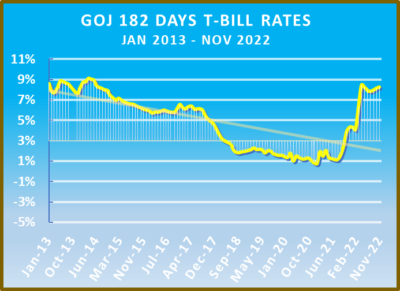 The rate is well over the trend since 2013, which suggests it should be just over 3 percent on a longer term. In 2013, the rate did not remain at its peak for long and continued decreasing gradually. It rose again to 9.11 in March 2014 for a brief period and fell to 6.99 percent by January 2015 and moved gradually down to under two percent by 2018.
The rate is well over the trend since 2013, which suggests it should be just over 3 percent on a longer term. In 2013, the rate did not remain at its peak for long and continued decreasing gradually. It rose again to 9.11 in March 2014 for a brief period and fell to 6.99 percent by January 2015 and moved gradually down to under two percent by 2018.
While the Bank of Jamaica has only recently pushed the Overnight rate to 7 percent the 182 days, Treasury bill rates were around 8 percent from April this year when the average was 8.46 percent and moderated slightly downwards since an indication that the market has determined that these rates are at or close to the peak. The decline in rates should start in the first half of 2023 and could adjust downwards gradually, as was the case in 2014.
The attached chart shows the trend-line slopping from the left side of the chart and reaching around two percent, with the current rates being well over trend, an indication that the recent hike since last year is not sustainable and could start to decline not too long from now with inflation rate now closer to 7 percent and falling.
Whether Jamaican interest rates?
BOJ now paying over 4% on CDs
Interest rates rose to 4.17 percent in the latest Bank of Jamaica 30 day CD offering of 12 billion on Wednesday last week, up from 3.28 percent on Wednesday, October 6 and well over the new overnight rate of 1.5 percent.
 Having settled at a low of just over 0.5 percent for the past two years, the latest rate marks a significant shift in a very short time frame, a development that investors should watch carefully.
Having settled at a low of just over 0.5 percent for the past two years, the latest rate marks a significant shift in a very short time frame, a development that investors should watch carefully.
At the recent auction, the central bank received 53 bids amounting to $14 billion for $12 billion on offer, 46 bids were successful up to 5.27 percent and came after BOJ increased their overnight rate to 1.5 percent. The total nominal outstanding amount for the 30-day CDs $46.5 billion, similar to the week before, but well above the $35.5 billion at the end of July.
At the same time, the Government of Jamaica Treasury bill auction on Wednesday, October 10, rates on the three tenors on offer ended with an average rate of 2.165 percent for the 90 day offer that attracted $2.246 billion for the $700 million on offer. The 181 days offer saw $1.974 billion chasing the $700 million offered and resulted in an average rate of 2.75 percent and the 273 days T-bill pulled in $1.865 billion for $800 million offered and resulted in an average rate of 3.69 percent.
The range for yields for full allotment is 1.45 percent to 2.85 percent for the 91 day T-Bill, 1.5 percent to 3.05 percent or the 182 days T-bill and 2.41 percent to 4.75 percent for the longest dated bill.
On Thursday, October 21, the central bank will auction $4.5 billion 365 days Certificate of deposit.
T-Bill plunged to lowest rates on record
In the latest Government of Jamaica Treasury bill (T-bill) auction, for April, rates hit their lowest level on record. The fall reversed the sharp uptick in rates at the March auction, with the average rate for the half-year instrument then hitting 2.01 percent and the three months 1.87 percent.
 At the April auction, T-bill rates dropped to 1.08 percent for the 91 days Treasury bills, while the 182 days instrument ended with an average of just 1.05 percent. The rate for the 273 days instrument, averaged 1.73 percent.
At the April auction, T-bill rates dropped to 1.08 percent for the 91 days Treasury bills, while the 182 days instrument ended with an average of just 1.05 percent. The rate for the 273 days instrument, averaged 1.73 percent.
In March, the demand dropped sharply to just $1.05 billion, for the half T-bills, the amounts applied for falling from $2.32 billion to $1.41 billion, in April, $2.46 billion chased after the $700 million on offer for the 90 days instrument, $2 billion went after the 181 days note and $1.5 billion chased down the 270 days bills. In each case, the GOJ offered $700 million to the public.
PE ratios continue to rise
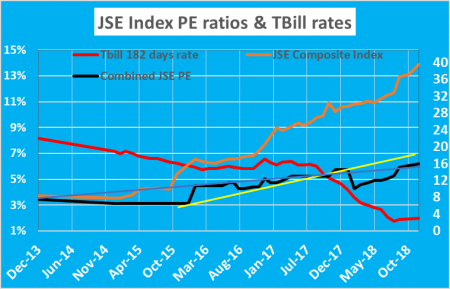 Treasury bills rates bottomed and have moved back closer in line with the Bank of Jamaica’s overnight rate of 2 percent.
Treasury bills rates bottomed and have moved back closer in line with the Bank of Jamaica’s overnight rate of 2 percent.
IC Insider.com is forecasting a further increase in T-bill rates to move above 2 percent, this could happen with the December Treasury bill auction.
In the mean time the main market of the Jamaica Stock Exchange has moved on the new record highs, with NCB Financial being the primary mover with the stock closing at $159.05 on Friday. The Junior Market that peaked at an all-time high in October has pulled back with no new price sensitive news to encourage aggressive buying.
The above developments are happening as the PE ratio of the market continues to inch higher. The ratio climbed slowly until June but moved much sharper thereafter, to better reflect the sharp fall in interest rates. The recent inching up of Treasury bill rates appears to have slowed the upward movement in the average PE ratio of the over all market that sits just under 16 currently. The average PE is now ahead of the longer term trend that goes back to 2013, but well below the trend, from late 2015 that suggests that the average PE is headed for 18, that will require a 15 percent rise in stock prices to get there. December is usually a bullish month and so the PE of 18 may be reached by year end or early in 2019.
Treasury bill rates at 4% level

Treasury bill rates now hovering around 4
Rates on 91 days Treasury bills fell below 4 percent for the first time in decades and the 182 days issue slipped to sit just above 4 percent at the mid-January Auction of Government of Jamaica Treasury bills.
The average rate for the 91 days instrument fell to 3.99 percent from 4.18 percent in December and the 182 days issue now sits at 4.16 percent down from 4.63 percent in December and is in line with IC Insider.com forecast that the rates would hit 4 percent during the current quarter. The Central Bank announced a 25 basis points cut in their overnight rate to 3 percent on Wednesday.
Treasury bill rates continue to fall
 Treasury bill rates in Jamaica continues to fall with the two latest issues of 91 and 182 days duration declining with the 91 days instrument falling to an average of 4.176 percent while the 182 days fell to 4.635 percent.
Treasury bill rates in Jamaica continues to fall with the two latest issues of 91 and 182 days duration declining with the 91 days instrument falling to an average of 4.176 percent while the 182 days fell to 4.635 percent.
The December decline, is the eight time in 2017, that the rates have fallen. Two amounts of $600 million each were offered to investors and $4 billion chased after them, with the longer dated issue attracting just over 56 percent of the total. The trend suggests that rates on the longer term instrument should fall below 4 percent in early 2018.
The effect of downward movement of rates goes much further than just the money market. Stocks and real estate investments are set to rise in value as a result of the continuing fall in rates and mortgages rates should fall as well.
 At the March auction, for T-bill, rates moved up from 1.337 percent in February to 1.85 percent in March for the shorter-term treasury rate and from 1.387 percent for the 192 days to 1.796 percent. The rates are coming from a low of 1.252 percent and 1.453 percent, respectively in January this year.
At the March auction, for T-bill, rates moved up from 1.337 percent in February to 1.85 percent in March for the shorter-term treasury rate and from 1.387 percent for the 192 days to 1.796 percent. The rates are coming from a low of 1.252 percent and 1.453 percent, respectively in January this year.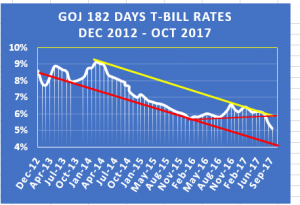 Treasury bill rates dropped sharply again in the latest Government of Jamaica’s October auction. Rates on the 182 days instrument, fell 34 basis points to 5.11 percent having dived 53 basis points to
Treasury bill rates dropped sharply again in the latest Government of Jamaica’s October auction. Rates on the 182 days instrument, fell 34 basis points to 5.11 percent having dived 53 basis points to 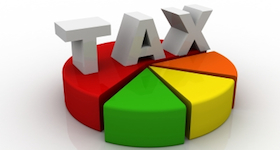
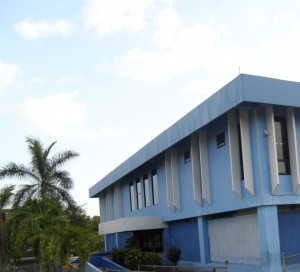
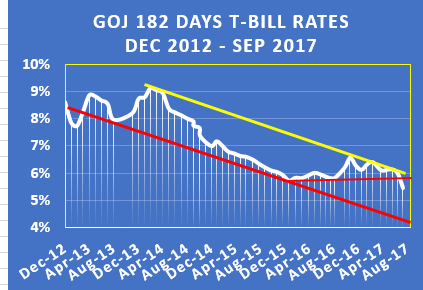 Interest rates are falling with the Treasury rates falling sharply in the latest auction last week.
Interest rates are falling with the Treasury rates falling sharply in the latest auction last week. 





